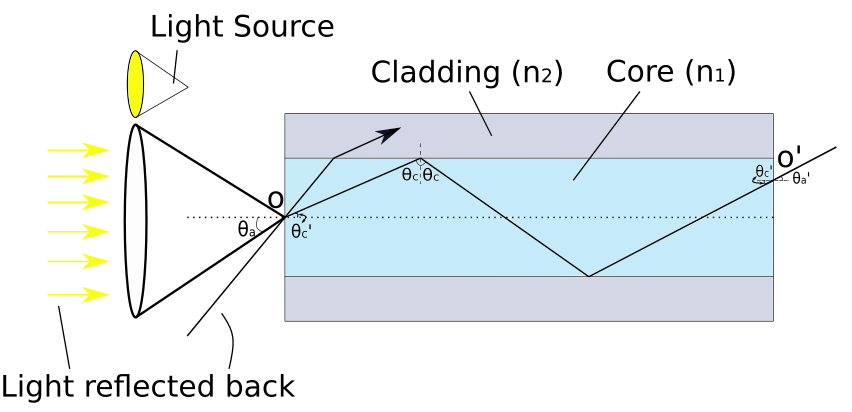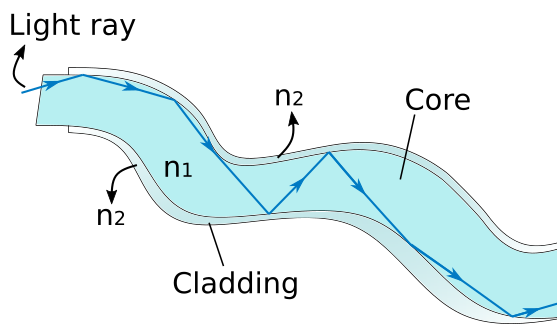What is total internal reflection?
Total internal reflection is a phenomenon of light in which the light in a medium completely reflects back into the medium from its surroundings.
Total internal reflection occurs when the angle between the incident light and the normal of the boundary (θ1) is greater than the critical angle θc. The effect consists of no light being refracted into the second medium and all light being reflected.
The critical angle θc is the name given to the incident angle that produces an angle of refraction of 90°.
The refractive index n specifies how fast light can travel through the medium. The refractive index and the speed of light in the medium are inversely proportional.
Let’s look at the diagram below where the light beam is travelling from a medium that has a refractive index of n1 to a second medium with a refractive index of n2 and n2 < n1.

Figure 1. The behaviour of a light beam related to the refractive index and the angle of incidence. Source: Oğulcan Tezcan, StudySmarter.The mirrors we use in our daily lives reflect around 90% of the light falling on them while absorbing the rest. This ‘absorbed’ portion of the light is refracted, as shown in Figure 1 (a). As the refraction index of the second boundary n2 is less than the refraction index of the first boundary, the refraction angle θ2 is bigger than the incident angle θ1.
When the incident angle θ1 increases, the refraction angle θ2 also increases. However, this can only be as high as 90°, which happens when the incident angle is equal to the critical angle θc (Figure 1 (b)).
The total internal reflection of light occurs when the incident angle of light θ1 is bigger than the critical angle θc (Figure 1 (c)). Total internal reflection depends on Snell’s law, which states that the relation between the incident angle and the refraction angle can be expressed as:
\[n_1 \cdot \sin \theta_1 = n_2 \cdot \sin \theta_2\]
Snell’s law states that between two given mediums, the sines of the incident and the refraction angles’ ratio are constant.
As we said, the refraction angle is 90° when the incident angle is equal to the critical angle or θ1 = θc. As sin(90°) = 1, the equation is as follows:
\[n_1 \cdot \sin \theta_1 = n_2\]
Thus, the critical angle between two materials’ boundaries where n1 > n2 can be determined with the following equation:
\[\theta_c = \sin^{-1} \Big(\frac{n_2}{n_1} \Big)\]
We should note that there are two conditions that need to be fulfilled in order for the total internal reflection of light to occur. (1.) The incident angle must be greater than the critical angle: θ1 > θc. (2.) The initial medium’s refractive index must be greater than the second medium’s refractive index: n1 > n2.
What are optical fibres?
Optical fibres or fibre optics have applications in a variety of fields, such as communications to transmit telephone signals, cable signals, TV signals, the internet, and medical signals. These fibres are very thin, which allows light to enter from one side and strike the inside of the fibre with an angle greater than the critical angle, which causes them to travel through the fibre and exit it at the same angle as the entry angle.
Endoscopes are devices used in medical physics to view the interior passageways of the human body. In endoscopes, optical fibres are coated with a material called cladding.
Cladding is the coating outside of optical fibres that have a refractive index that is smaller than the material inside the optical fibre and thus prevents light from being refracted between the fibres in a bundle.

Figure 2. Light paths inside a fibre optic. Source: Oğulcan Tezcan, StudySmarter.While light with an incidence angle greater than the maximum acceptance angle θa is partially refracted outside the fibre, light with an incidence angle greater than the maximum acceptance angle θa is partially refracted inside the fibre. After several encounters with the fibre core-cladding interface, the residual, partially reflected light is finally lost. The requirement for 100% internal reflection at the core-cladding contact determines the maximum acceptance angle θa.
To determine the acceptance angle θa, we should look at the equation that yields the critical angle θc.
\[\sin(\theta_c) = \frac{n_2}{n_1}\]
As you can see in Figure 2, θc' = 90°-θc. The equation thus helps us to determine the acceptance angle θa, assuming the fibre is in the air with a refractive index of 1. This can be expressed as follows:
\[\sin(\theta_a) = \frac{n_1}{1} \cdot \sin(\theta'_c)\]
As noted before, the light exits the fibre at the same angle at which it entered it, which means that θa = θa'.
- In conclusion, the light wave that reflects back from the human body’s passageways and enters the endoscope’s fibre optic travels through the fibre optic with total internal reflection. The light thus exits the fibre optic at the same angle at which it entered it. The image is, therefore, transferred in a way that a viewer can examine it.

Figure 3. A light beam travelling through an optical fibre. Source: Oğulcan Tezcan, StudySmarter.Total Internal Reflection In Optical Fiber - Key takeaways
- Total internal reflection is a phenomenon of light that occurs when the angle between the incident light and the normal of the boundary θ1 is greater than the critical angle θc.
- An optical fibre is a nonconducting waveguide that transmits light along its axis by total internal reflection.
- Optical fibres or fibre optics have applications in a variety of fields, such as communications to transmit telephone signals, cable TV signals, the internet, and medical signals.
- For the total internal reflection of light to occur, the incident angle θ1 must be greater than the critical angle θc, and the initial medium’s refractive index n1 must be greater than the second medium’s index n2.










